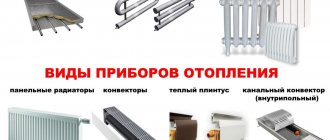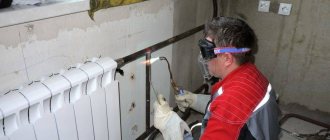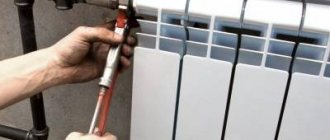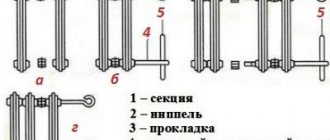Many people are interested in how exactly to replace a heating radiator? In fact, this issue may require certain skills and thoughtful actions, otherwise you can create an emergency situation for your house or apartment and ruin not only your own property, but also your neighbor’s. In this article, we will describe in detail the basic principles by which new heating radiators need to be installed. With their help, even a person who is not sufficiently qualified can perform this procedure with minimal loss of time and money.
From the article you will learn:
- Under what conditions does a heating radiator need to be replaced?
- How to change a heating radiator through the housing office
- How to get permission to change a heating radiator yourself
- How to change a heating radiator in an apartment with your own hands
- How much does it cost to replace heating radiators in an apartment?
- What to do if you replaced the heating radiators, but they do not heat
- How to change a section on a heating radiator
Under what conditions does a heating radiator need to be replaced?
It is not often that the question of replacing heating equipment arises. Given this fact, not every resident of our country has the appropriate qualifications to replace radiators. It is necessary to change batteries when performing major home repairs, when there are visible defects in the radiator itself, due to poor installation or wear and tear over time. Low-quality heating equipment can also play a significant role. The battery may rupture due to a sudden change in pressure in the heating system or the so-called water hammer.
Another reason for replacing a heating radiator may be the appearance of salts on its internal walls, which leads to clogging of the ducts. This also happens due to contamination of the liquid in the pipes. In this case, the battery becomes inefficient and is unable to transfer heat fully. In apartment buildings, replacing the radiator with a new one with an increase in the number of sections is the optimal solution for maintaining a comfortable temperature in their home.
As for private houses, replacing the heating battery with a newer and more modern system can increase the efficiency of heating the room. At the moment, there is a huge selection of different heat transfer control systems that work only in conjunction with certain new types of radiators.
It is worth noting that even when using the most reliable equipment, everything has a limited service life. This also applies to heating radiators. If replacement is not carried out in a timely manner, this can have serious consequences, especially in winter.
How to change a heating radiator through the housing office
For multi-storey buildings, the heating system is built in such a way that the apartment in it is connected to the entire system of the house. This means that unqualified replacement of heating equipment cannot be carried out, as this will lead to breakdowns throughout the house. Residents can use housing office services in the following cases:
- The batteries have expired.
- One of the heating devices has failed.
Other cases involve local repairs or maintenance only. According to standards, the service life of a cast iron radiator is 15-30 years in open systems and up to 40 years in closed systems. If the service life of your radiators is already longer, you need to submit a corresponding request for replacement to the Housing Office. Replacing batteries is included in the cost of major home repairs, the timing of which the office may not have information about.
In order to replace radiators, you must write an application. It must be formatted accordingly to avoid delays. The application is written in duplicate, taking into account the complexity of negotiations with management companies. In one of the copies, you need to ensure that an employee of the management company puts a mark on the date and registration number of the application. This copy should remain in the hands of the applicant, as it will help in further possible proceedings with housing office employees.
When communicating with representatives of the management company, you should always focus on the fact that in the event of a breakdown, it is the housing office that will compensate for the full damage to the residents in the event of untimely replacement of heating equipment. In practice, resolving the issue through the housing maintenance office is a very labor-intensive and troublesome process. For this reason, many residents prefer to resolve this issue on their own. However, knowing your rights helps you to communicate correctly with representatives of such organizations in the future.
When an apartment owner decides to replace his battery, he must choose the right type of device. This should be done taking into account all characteristics, both technical and aesthetic. When choosing a heating battery, you need to pay attention to the following parameters:
- For every 2 sq. meter there should be one section of the new radiator. If the entire area is heated, additional sections must be added.
- According to the standards, in order to heat a room in a brick building, a thermal power of 34 W is required. Characteristics for a panel house - 41 W and for a new building - 20 W.
It is imperative that you agree on your decision to replace radiators with the management of the housing office. All necessary calculations of heating systems are performed based on the number of batteries, the volume of coolant in the pipes and the power of the heating equipment. If a radiator is changed without approval from the housing office, this may affect the heating parameters in the entire system.
How to get permission to change a heating radiator yourself
If replacing radiators through the management company is not possible, you should definitely obtain permission to independently change heating radiators. To do this, you need to collect and provide the following documents:
- Application for independent replacement of radiators
- Technical passport for housing and title documents
- Documents on thermal calculations of equipment that will be installed.
- Certificates of conformity for all related accessories (shut-off valves, filters, fittings, etc.).
The application is usually processed within 60 days, so it is necessary to resolve this issue in advance. To replace the battery, you must submit an application to turn off the corresponding riser along with draining the coolant from the heating system. After installing new heating equipment, an application for a technical examination is written.
Procedure time
It will take approximately 2.5 hours to change the batteries.
If you have the necessary equipment and experience in handling it, you can replace heating devices quickly and efficiently.
Calculation for one product:
- drafting - 10 min;
- cutting off supply and return - 5 minutes;
- removal and removal of the old radiator - 5 minutes;
- installation of a heat shield - 15 min;
- installation of brackets - 10-15 minutes;
- assembly of the circuit with a ball valve - 40-60 minutes;
- fastening the Mayevsky crane - 5 min;
- connection of wiring - 10 min;
- assembly quality check - 10 min.
It will take no more than 2.5 hours to replace the battery in one room. For repairs in a standard two-room apartment, 8 hours are enough, including a lunch break.
How to change a heating radiator in an apartment with your own hands
In order to replace the heating radiator yourself, you must follow the following step-by-step instructions:
STEP 1. Selecting a heating radiator
Before choosing a heating radiator, it is necessary to study in detail the information on the types and varieties of this equipment. Heating batteries are classified into the following types:
- column-type batteries - constructed of 2 collectors connected by columns in the form of tubes. They are made from aluminum alloys.
- panel radiators - a structure made of several panels along which a heat-transmitting liquid moves. They are usually made of steel and are adaptable for side or bottom connection.
- sectional batteries - consist of several sections. The coolant is distributed through these sections. The number of sections can only be limited by the maximum weight. You can install radiators made of bimetal, cast iron, steel or aluminum, depending on operating conditions.
Batteries should be of high quality, whether you decide to install them yourself or hire a professional. Let's consider the basic principles for choosing high-quality heating radiators:
- Strength characteristics. In addition to price and operating characteristics, radiators must be durable and reliable. These parameters are determined by the operating pressure of the fluid indicated in the documents. The choice should be made on new equipment with increased strength characteristics in order to avoid an emergency situation in the event of pressure surges in the system. For example, in order to supply liquid to the upper floors of an apartment building, it is necessary to create high pressure, which an aluminum radiator may not be able to cope with. In such buildings only new bimetallic radiators are used. The operating and maximum permissible pressure values can be found in the product data sheet.
- Heat transfer level. Heat transfer is the main task of this heating equipment. Therefore, radiators need to be selected properly so that there is appropriate power. This is indicated in the product passport, taking into account that to heat one square meter, a power of 80-120 W is needed.
- Corrosion resistance. This is another one of the main conditions when choosing a high-quality heating radiator. The leading positions are occupied by cast iron batteries, while the lowest indicators are shown by products made of aluminum. For the latter, i.e. aluminum radiators, you need to add special additives to the liquid to prevent corrosion.
The most significant point is the heat transfer indicators for heating the room. The battery passport indicates its thermal power, which is calculated based on the proportion - 80-120 W of thermal power is needed per 1 square meter.
Let's look at the characteristic features of radiators made from various materials:
- Aluminum radiators. Due to its low weight, replacement can be done without installing high-strength fasteners. Such batteries are distinguished by their good thermal conductivity, aesthetic appearance and design.
- Steel radiators. The most popular type for heating systems in apartments. They are distinguished by high corrosion resistance and ease of replacement.
- Cast iron radiators. Among the advantages we can safely highlight the affordable cost, as well as a long service life. In order for heat transfer rates to be high, it is necessary to install a large number of sections.
- Bimetallic radiators. Ideal for apartments in multi-apartment buildings. Aesthetic appearance and relatively light weight make these radiators attractive for purchase. Installing them is not difficult.
STEP 2. Preparing the site and selecting tools
The best way to replace radiators is to agree with the neighbors below and above to completely change the heating pipes. The optimal solution would be to obtain consent to insert a pipe from the radiator outlet at the top to the radiator inlet at the bottom. This will allow your neighbors to update part of the pipe at your expense, and you will quickly replace the heating radiator without additional cutting of the pipe.
If the neighbors still refuse this option, it is necessary to cut the pipe in the apartment from ceiling to floor and cut it with a reinforced polypropylene pipe. It is necessary to pay attention to the fact that polypropylene, metal-plastic, and also metal pipes welded on bends are used. The most popular is the metal-plastic construction. It is easy to install and has a longer service life.
Before replacing the heating radiator, it is necessary to shut off the water supply to the system. Next, the maximum possible volume of water is pumped out and the pipe near the radiator is closed. Containers should be prepared so that the remaining liquid during the process of dismantling the old battery is drained there.
After the old battery is removed, proceed to the following:
- We measure and record the parameters of the pipe coming out of the radiators of the neighbors above and below.
- We calculate the length of the pipe required to connect the apartment from above, taking into account the thickness of the floors.
- Measure the distance to the neighbor's radiator below, taking into account the thickness of the ceilings.
- Measure the pipe that will pass through your apartment
- When choosing pipes, you need to choose a similar diameter, such as when connecting an old radiator, in order to avoid water hammer when the diameters differ.
Another thing you need to remember when installing new heating equipment is the accessories that you need to purchase for a complete installation:
- Four plugs are needed - two blind and two through, on one of which a Mayevsky valve is placed to bleed air.
- Gaskets for each radiator plug
- Dismountable shut-off valves, which will be required to shut off the radiator for the purpose of its subsequent replacement
- A polypropylene ball valve required to turn on the heating system without a dismantled radiator.
- End connections for connecting to neighboring radiators.
In order to replace the battery yourself, you need a certain set of tools. It includes:
- Pipe welding machine
- Adjustable and gas wrench
- Angle grinder with cutting disc for metal
- Tape measure and pencil
- A drill with a drill used to make holes for mounting radiators.
- Level
If the heating radiator is being replaced with a tap into an old pipe, you will need a tool to apply the external thread.
Step 3. Work on removing old heating equipment
Heating radiators are usually connected to heating pipes using pipes. If replacement is necessary, this is the most effective remedy. In order to remove the old heating radiator, we will use the following algorithm of actions:
- Unscrew the locknut to the very end of the thread, both at the bottom and at the top where the pipe connects to the radiator.
- Using a level, measure the cutting point. A minimum of 10mm thread must be left.
- The level is used to accurately cut the pipe horizontally. If the pipe is cut crookedly, this will significantly complicate the process of replacing the radiator.
- Cutting according to specified marks and removing the old radiator from its mounts. After the battery is removed, the old fasteners are removed from the wall.
- If the new radiator differs in size from the previous one, the pipes should be cut to the required parameters and threaded. If the system is already quite old, it will be more effective to use welding, since threading can lead to deformation along the seam.
- In order to lengthen the pipe, special ecoplastic inserts are used.
- Threaded connections are processed using an angle grinder. To remove burrs, it is better to unscrew the locknut.
STEP 4. Marking and installation of a new radiator
The radiator must be fastened to the wall at predetermined points. In this case, the following main nuances are observed:
- The bottom of the radiator should be at a distance of 10 to 15 cm from the floor. If you replace the battery in violation of these parameters - hang it too low, this will complicate the passage of air and make cleaning under the radiator very difficult.
- In order to ensure normal air conditioning, it is necessary to place the radiator at a distance of at least 15 cm from the window sill.
- If the battery is too pressed against the wall, this will interfere with its heat transfer, so this distance must be adjusted. This can be done by screwing in the mounting brackets. The ideal distance from the wall is considered to be from 30 to 40 mm.
When replacing a heating radiator, you must adhere to the following algorithm of actions:
- If replacement is planned in winter, you must first agree with the management company to turn off the riser. In most cases, such permission is given only in case of emergency condition of radiators or low temperature in apartments where there are small children.
- After the riser is turned off, the drain valve opens. After this, you can replace the heating radiator. Liners are installed on the new heating battery, and the supply pipes are equipped with ball valves.
- When installing ball valves, a sealant must be applied to the threads. Tow has the highest efficiency. Previously, tow was used together with paint, but now special pastes are provided, which, together with the sealant, provide sufficient tightness of the joints. It is best to wind the sealing material in the form of tow along the thread clockwise from the edge. After which the paste is applied and the connection occurs.
- Connect the tap so that the threads are completely hidden. After the paste dries on the tow, the connection is tight and reliable.
- The battery is connected to the pipes with two internal threads, into which the fittings must first be screwed. On one side, the nuts will be installed on the left-hand thread, and on the other, on the right-hand thread. Through passage nuts are used, with the help of which the radiator is mounted in different positions. The fittings are usually attached using paronite or rubber seals.
- In those places where radiators are connected, it is necessary to install the mating parts of the collapsible connections, after which a plug is screwed in at the lower inlet, and an air vent, a Mayevsky valve, is screwed in at the upper inlet.
- Next, the radiator is raised, and the taps are connected to the already installed American ones. This will prevent the radiator from falling during installation. You can place a cardboard sheet underneath.
- The radiator is mounted using special brackets. In order to correctly install the fasteners, you need to make markings using a level. At the marks in the wall, holes are made for installing hooks.
- After the four hooks are secured, the nuts are tightened with an adjustable wrench.
Selecting the batteries correctly
Before purchasing a radiator for your apartment, it is worth checking with the service organization what the technical characteristics of the heating system are. This refers to the coolant temperature and pressure in the heating circuit, as well as the calculated specific power of the equipment per unit area in a particular house.
This is important, since the microclimate not only in this room, but also in neighboring ones, will depend on the correct change of heating batteries in the apartment. Without the necessary initial information, it will be difficult to correctly select a radiator for your apartment. Taking into account the data obtained, it is necessary to understand in more detail the characteristics of possible battery options and find out how appropriate it is to use them in central heating conditions.

Please note that not every radiator is resistant to the aggressive environment in the heating circuit - the coolant is saturated with oxygen, and during pressure surges water hammer cannot be ruled out. The main requirement for radiators is their efficient operation under conditions of a given pressure and composition of the coolant, that is, they must provide high-quality heating of the room.
An important argument in favor of one type of radiator or another can be their appearance - the device must be in harmony with the interior of the room.
How much does it cost to replace heating radiators in an apartment?
There are now a lot of offers on the Internet for the services of specialists involved in the installation and replacement of heating radiators. The cost of services on the bulletin board usually ranges from 800-5000 rubles. At the same time, it is quite difficult to understand where the price is indicated specifically for installation, and where for the entire range of work performed. If we consider the proposals, we can find those that indicate work only on replacing radiators without preliminary dismantling, as well as without installing brackets and connecting to the system. With this option, all responsible work falls on the shoulders of the owner. The customer wants to receive the full cost of services for the entire range of work, which means installation of radiators on a turnkey basis. The list of standard services includes the dismantling of old heating equipment and installation of new ones without reconstruction of connection systems. The technician does not cut threads or transfer battery mounts.
Before replacing the radiator, it is necessary to calculate the full cost of this procedure. The first thing you need to pay attention to is the cost of a new radiator. The market now provides a huge selection of different batteries made of different materials, so it’s difficult to take this point into account right away. After purchasing a radiator, you need to shut off the riser and drain the liquid from the system. This work should only be carried out by specialists from the operating office or management company. The procedure is approximately estimated at 500 rubles, but the human factor can make adjustments to this pricing.
All remaining expenses go mainly to the purchase of materials. In order to completely replace the heating radiator, it is necessary to purchase the following spare parts:
- Two collapsible American type taps with a thread diameter of ¾.
- A set of fittings with a Mayevsky tap for connecting the battery to the pipes
- Brackets for hanging the radiator (the number depends on the size of the radiator)
- Squares at 45 degrees
- Four adapters to polypropylene with internal thread
- Two tees
- 2 meters of polypropylene pipe
The cost is approximately 1800 rubles. This amount is sufficient to purchase everything needed to replace a heating radiator. However, it is worth noting that this is a minimum calculation.
Next, you need to take into account the costs of the specialist’s work. The average price tag for this service starts from 2.5 thousand rubles. This amount is only for the work itself. The cost may vary significantly depending on the region. Let us indicate all the approximate expense items that were mentioned earlier:
– specialist work – 2500 rub.
— materials for connection – 1800
— riser disconnection services – 500
The total amount is 4800 rubles. In any given case, this figure may be completely different, but it consists of all these components. If the goal is to replace a heating radiator, then the use of metal-plastic pipes and fittings significantly increases the cost of this procedure. The set is practically unchanged and includes:
- Two taps with a diameter of ¾ American type
- Set of footers and Mayevsky tap
- Mounting brackets
- Tees 20-16-20 (2 pieces)
- Fitting diameter ¾ external thread for 20 pipe (2 pcs.)
- Fitting diameter ¾ internal. thread for 20 pipe (2 pcs.)
- Pipe with a diameter of 20 (2 meters).
This configuration option will cost more - 2300 rubles, while the total amount will be 5300 rubles. Again, the cost can be much more expensive depending on the region.
Many may have a question: is it possible to somehow reduce the cost of replacing a radiator? There is such a method, but it will lack shut-off valves and jumpers. This case does not provide for temperature adjustment, so this can only be done by opening the window. In order to replace the radiator using a budget option, you need to purchase the following kit:
- Set of footers and Mayevsky tap
- Mounting brackets
- Connection with a diameter of ¾ with no. for 25 pipe (2 pcs.)
- Connection with a diameter of ¾ with int. r for 25 pipe (2 pcs.)
- Pipe diameter 25 – 2 meters
The kit will cost only 800 rubles, while replacing the radiator completely will cost 3,800 rubles.
A set of tools and components for work
Before replacing the battery in your apartment, you should stock up on consumables and a set of tools that you will need for the job.
The minimum set of tools includes:
- an adjustable wrench and several wrenches;
- grinder for cutting metal pipes;
- die for cutting threads on metal pipes or dies with a holder of the required diameter;
- machine for welding polypropylene pipes;
- tools for cutting polypropylene pipes (hacksaw or scissors);
- ruler, pencil, level;
- sealant;
- tow;
- cement mortar.
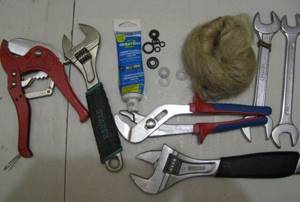
The following components and consumables will be required:
- batteries of the selected type;
- brackets for mounting radiators;
- Ball Valves;
- Mayevsky taps to bleed air from the system;
- plugs;
- heating steel, metal-plastic or propylene pipes with a set of fastening elements - tees, bends, fittings, transitions and other parts.
What to do if you replaced the heating radiators, but they do not heat
The most common mistake when installing a new heating radiator is incorrect connection. When liquid is supplied from below into the battery, heating is not carried out evenly throughout the entire structure. To solve this problem, you do not always need to replace the radiator. To solve this problem it is not necessary to change the radiator. To do this, it is enough to use a special duct extension. A specialist can correctly calculate and improve the system for sufficient heat transfer. In order for the heating efficiency of the premises to be at a high level, it is necessary to take into account the number of units. In a gravity system, this number will usually be no more than 12; in a circulation system, the number of nodes reaches 24. An increase in the number of sections always leads to a decrease in the efficiency of heat transfer.
Another feature that affects the uniform heating of the battery is the diameter of the connected pipes. A small diameter leads to a decrease in pressure, which leads to insufficient heating of the radiator. In order to eliminate this problem, old pipes are replaced with pipes of larger cross-section.
Increased heat transfer can be achieved by placing reflective material on the wall behind the new radiator or by painting the battery in a dark color. Maintaining the cleanliness of the heating system also has a significant effect on warming up the battery. The quality of radiator performance can be improved by installing the latest thermostat systems. By agreement with the employees of the housing office or management company, it is possible to remake the system without a bypass pipe.
One of the most common reasons for poor radiator heating is a system that has been repaired. To understand what exactly happened, it is necessary to fully analyze all the changes and their impact on the heating system. If during the installation of boxes and plasterboard partitions that covered communications, the plasterboard and radiator were allowed to come into contact, the heat transfer will be reduced. In this case, part of the heat generated will go into the space between the drywall and the wall. In the case where before the changes the radiator did not completely give off heat, after such metamorphoses it will simply stop giving it away, since it will heat a foreign object. To eliminate this situation, the design is completely redesigned, then the efficiency of the battery in heating the given room is monitored again.
Where is the best place to install heating devices?
For maximum efficient heating, you need not only to choose the right radiator, but also to position it correctly. The most suitable place to install batteries is under the window.

Correct location of the heating radiator
Some models, for example, vertical ones, are installed on a load-bearing wall anywhere in the room. The radiators located under the window will prevent cold air from the street from entering the room, heating it and lifting it to the ceiling. For proper operation of the heating device, it is important to maintain the required distance from the wall, window sill and ceiling.
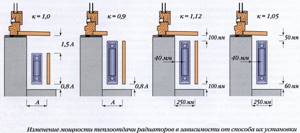
Attaching heating radiators to the wall
The distance to the wall should be 3 cm, and to the floor and window sill - about 10-15 cm. Some models must be installed at a barely noticeable angle so that air does not accumulate inside.

